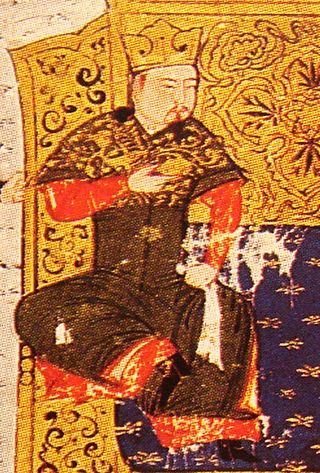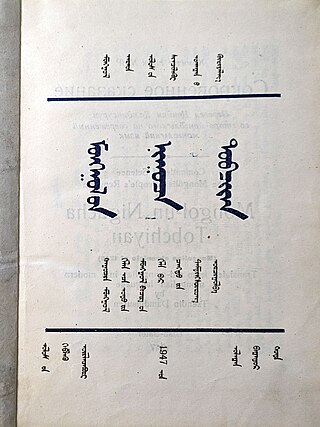Börte Üjin, better known as Börte, was the first wife of Temüjin, who became Genghis Khan, the founder of the Mongol Empire. Börte became the head of the first Court of Genghis Khan, and Grand Empress of his Empire. She was betrothed to Genghis at a young age, married at seventeen, and then kidnapped by a rival tribe. Her husband's rescue of her is considered one of the key events that started him on his path to becoming a conqueror. She gave birth to four sons and five daughters, who, along with their own descendants, were the primary bloodline in the expansion of the Mongol Empire.

Tolui was the youngest son of Genghis Khan and Börte. A prominent general during the early Mongol conquests, Tolui was a leading candidate to succeed his father after his death in 1227 and ultimately served as regent of the Mongol Empire until the accession of his brother Ögedei two years later. Tolui's wife was Sorghaghtani Beki; their sons included Möngke and Kublai, the fourth and fifth khans of the empire, and Hulagu, the founder of the Ilkhanate.

Jochi, also known as Jüchi, was a prince of the early Mongol Empire. His life was marked by controversy over the circumstances of his birth and culminated in his estrangement from his family. He was nevertheless a prominent military commander and the progenitor of the family who ruled over the khanate of the Golden Horde.

Chagatai Khan was a son of Genghis Khan and a prominent figure in the early Mongol Empire. The second son of Genghis's wife Börte, Chagatai was renowned for his masterful knowledge of Mongol custom and law, which he scrupulously obeyed, and his harsh temperament. Because Genghis felt that he was too inflexible in character, most notably never accepting the legitimacy of his elder brother Jochi, he excluded Chagatai from succession to the Mongol throne. He was nevertheless a key figure in ensuring the stability of the empire after Genghis's death and during the reign of his younger brother Ögedei Khan.

A Borjigin is a member of the Mongol sub-clan that started with Bodonchar Munkhag of the Kiyat clan. Yesugei's descendants were thus said to be Kiyat-Borjigin. The senior Borjigids provided ruling princes for Mongolia and Inner Mongolia until the 20th century. The clan formed the ruling class among the Mongols and some other peoples of Central Asia and Eastern Europe. Today, the Borjigid are found in most of Mongolia, Inner Mongolia and Xinjiang, and genetic research has shown that descent from Genghis Khan and Timur is common throughout Central Asia and other regions.

The Secret History of the Mongols is the oldest surviving literary work in the Mongolian language. Written for the Mongol royal family some time after the death of Genghis Khan in 1227, it recounts his life and conquests, and partially the reign of his successor Ögedei Khan.

Hö'elün was a noblewoman of the Mongol Empire and the mother of Temüjin, better known as Genghis Khan. She played a major role in his rise to power, as described in the Secret History of the Mongols.
Khasar, was one of the three full brothers of the legendary Genghis Khan. According to the Jami' al-Tawarikh, his given name was Jochi and he got the nickname Khasar after his distinguished bravery. He was also called Khabht Khasar because he was skilled with a bow.

The Battle of Köse Dağ took place in eastern Anatolia on 26 June 1243 when an army of the Sultanate of Rum, led by Sultan Kaykhusraw II, confronted an invading Mongol army under the general Baiju and was decisively defeated. The battle was the pivotal event of the Mongol conquest of Anatolia: Rum, previously a significant independent power in the eastern Mediterranean, was reduced to the status of a client kingdom, and its territories were later formally annexed by the Mongol Ilkhanate.

Orda Ichen was a Mongol Khan and military strategist who ruled the eastern part of the Golden Horde during the 13th century.
Oghul Qaimish was the wife of Güyük Khan, the third ruler of the Mongol Empire, and was herself the nominal regent of the empire between Güyük's death in 1248 and the accession of Möngke Khan in 1251.

Genghis Khan, also known as Chinggis Khan, was the founder and first khan of the Mongol Empire. After spending most of his life uniting the Mongol tribes, he launched a series of military campaigns, conquering large parts of China and Central Asia.
Shigi Qutuqu was a high-ranking official during the early decades of the Mongol Empire. The adopted son of the empire's founder Temüjin and his wife Börte, Shigi Qutuqu played an important role in the codification of Mongol law, serving with distinction as an administrator in North China. He may also have been a major source for the Secret History of the Mongols, which portrays him very favourably.
Yesugei Baghatur or Yesükhei was a major chief of the Khamag Mongol confederation and the father of Temüjin, who later became known as Genghis Khan. Yesügei was from the Borjigin family, and his name means "like nine", meaning he had the auspicious qualities of the number nine, a lucky number to the Mongols.

Bodonchar Munkhag or, Bodonchar Khan was a renowned Mongol Borjigin Tribal-Chieftain and Warlord, He was a patrilineal ancestor of Genghis Khan who was the founder of Mongol Empire in 1206, as well as the Mongol Barlas tribe of the Central Asian Mongol conqueror Amir Timur who was the founder of Timurid Empire in 1370.
Al-Altan, also known as Altalun and Altaluqan, was the youngest child and favourite daughter of Genghis Khan, founder of the Mongol Empire, and Börte, his primary wife. As part of Genghis's policy of marrying his daughters to powerful rulers in exchange for their submission to him, she married Barchuk, the ruler of the wealthy Uighur people to the southwest, in around 1211.
Checheyigen was the second daughter of Genghis Khan, the founder of the Mongol Empire, and his first wife Börte. As part of Genghis's policy of marrying his daughters to powerful rulers in exchange for their submission, she married a prince of the Oirat tribe, who lived near Lake Baikal, in 1207. There, she assumed a high-ranking administrative role among her husband's people, organising people and flocks like other high-ranking nomadic women. Over the following decades, Checheyigen arranged a series of advantageous marriages for her seven children and, after she backed the successful side in the Toluid Revolution of the early 1250s, her Oirat family became one of the most powerful in the empire. However, her descendants failed to take full advantage of their position, and eventually lost most of their influence.
Alakhai Bekhi was the oldest daughter of Genghis Khan and his first wife Börte. She acted as Regent of the territories in China proper conquered by her father after he withdrew to the Mongolian Plateau in 1215.
The rise of Genghis Khan involves the events from his birth as Temüjin in 1162 until 1206, when he was bestowed the title of "Genghis Khan", which means something along the lines of "Universal Ruler" or "Oceanic Ruler" by the Quriltai, which was an assembly of Mongol chieftains.
The Battle of the Irtysh River or Battle Along the Buqdarma was a battle between the Mongol Empire and remnants of the Merkit and Naimans, fought at the junction of the Bukhtarma with the Irtysh in late 1208 or very early 1209. The Merkit had a longstanding rivalry with the Borjigin, the family of Genghis Khan, and together with the Naimans opposed Genghis Khan's rise to power. The Battle of Chakirmaut in 1204 shattered the forces of the Merkit-Naimans alliance and the survivors fled into southern Western Siberia. When Jochi, the son of Genghis, led an expedition into Siberia to subjugate what the Mongols called the "Forest Peoples", he encountered the remnant armies of the Merkits and Naimans at the Irtysh and soundly defeated them, shattering the alliance. The Merkit commander Toqto'a was slain and the Naiman leader Kuchlug fled.









